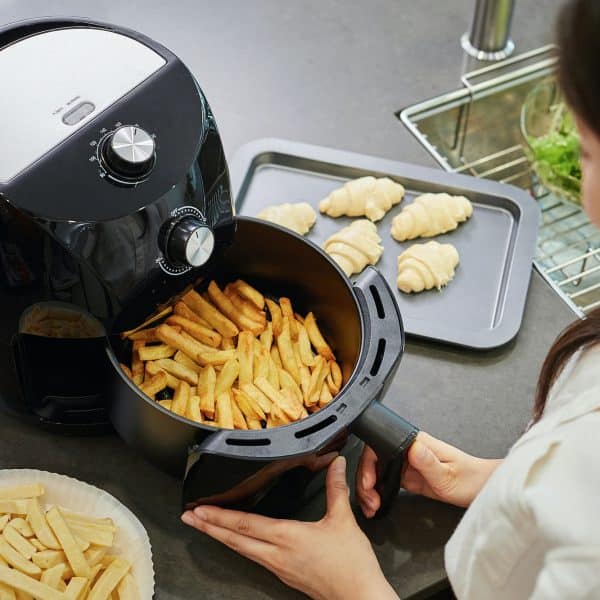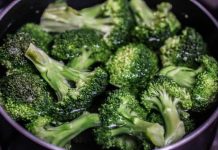Let us take you on a culinary adventure as we explore the fascinating world of air fryers. Have you ever wondered how this magical contraption can cook deliciously crispy food without excessive oil?
Prepare to be amazed as we uncover the secret behind the air fryer’s revolutionary cooking technique.
From its innovative circulation system to its ability to create the perfect balance of heat and airflow, we will uncover the science behind this kitchen marvel. Get ready to discover a healthier way to indulge in your favorite fried treats with the help of an air fryer.
How Does an Air Fryer Work?
Overview of Air Fryers
Air fryers have recently gained popularity as a healthier alternative to traditional deep frying methods. These innovative kitchen appliances use hot air instead of oil to cook food, producing crispy and delicious dishes with significantly less fat. Understanding how an air fryer works can help you make the most of this versatile and convenient cooking tool.
Heating Mechanism
The heating mechanism in an air fryer is essential for achieving your food’s desired texture and taste. Most air fryers utilize an electric heating element located above the cooking chamber. This element generates heat and rapidly warms the air inside the fryer. As a result, the temperature inside the fryer reaches the desired level for cooking.
Circulation of Hot Air
To ensure even cooking, air fryers rely on hot air circulation. They employ a technology known as rapid air technology, which involves the use of a powerful fan. This fan distributes the hot air throughout the cooking chamber, ensuring that every part of the food receives equal heat. This circulating hot air is what creates the crispy exterior of air-fried dishes.
Cooking Process
Using an air fryer involves a straightforward cooking process. The fryer must be preheated, allowing the heating element to warm the air inside. Once preheated, the food is placed in the fryer’s cooking basket or tray. The temperature and cooking time is then set using the control panel. The hot air circulates the food, cooking it evenly and efficiently. The fryer’s fan helps maintain a consistent temperature throughout the cooking process, ensuring consistent results.
Benefits of Using an Air Fryer
There are numerous benefits to using an air fryer in your kitchen. One of the main advantages is the ability to cook with significantly less oil compared to traditional frying methods. This makes air frying a healthier option for those who want to reduce their fat intake and enjoy delicious, crispy foods. Additionally, air fryers offer rapid cooking times, allowing you to prepare meals in a fraction of the time it would take with other cooking methods. The versatility of air fryers is another advantage, as they can be used to cook a wide range of dishes, including everything from French fries to chicken wings and even desserts. Lastly, air fryers are easy to use and clean. Most models feature user-friendly interfaces and removable, easily washed components, making cleanup a breeze.
Overview of Air Fryers
Definition and Function
An air fryer is a countertop kitchen appliance that uses hot air to cook food. It operates by circulating hot air around the food, providing a similar frying effect without the need for excessive oil. The function of an air fryer is to create crispy, golden-brown exteriors on various foods, all while reducing the amount of oil used in the cooking process.
Design and Components
Air fryers typically have a compact and sleek exterior design, making them suitable for any kitchen. The critical components of an air fryer include an exterior housing, an inner cooking basket or tray, a control panel, and a heating element. The exterior housing houses the internal components, while the cooking basket or tray is where the food is placed for cooking. The control panel allows the user to adjust the temperature and cooking time and select various cooking modes. The heating element generates the heat necessary to cook the fryer’s food.
This image is the property of helios-i.mashable.com.
Heating Mechanism
Electric Heating Element
The electric heating element in an air fryer plays a vital role in the cooking process. When the fryer is switched on, the heating element generates and distributes heat throughout the cooking chamber. As the air inside the fryer is heated, it reaches the desired temperature for cooking. This heating element cooks the food evenly and creates the desired texture.
Hot Air Technology
Hot air technology is the primary mechanism behind an air fryer’s cooking ability without oil. The rapid air technology used in air fryers ensures that the hot air circulates throughout the cooking chamber, surrounding the food from all angles. This allows the food to cook evenly and achieve a crispy exterior without deep frying. By using hot air instead of oil, air fryers reduce the fat content of your favorite fried foods, making them a healthier alternative.
Circulation of Hot Air
Rapid Air Technology
Rapid air technology drives an air fryer’s ability to cook food quickly and evenly. This technology uses a powerful fan circling hot air within the cooking chamber. The fan ensures that the hot air reaches all parts of the food, promoting even cooking and eliminating the need for flipping or stirring. The rapid hot air circulation ensures that the food’s exterior becomes crispy and golden while the interior remains moist and tender.
Fan System
The fan system in an air fryer is responsible for ensuring the even distribution of hot air. This system has a high-powered fan that draws the air from the surrounding environment and propels it into the cooking chamber. The fan operates at a consistent speed to maintain a steady flow of hot air throughout the cooking process. This continuous circulation guarantees that the food is cooked thoroughly and obtains the desired texture and taste.
This image is the property of i.ytimg.com.
Cooking Process
Preheating
Preheating is an essential step in the cooking process of an air fryer. By preheating the fryer, the internal temperature reaches the desired level for cooking, ensuring that your food cooks evenly and efficiently. Preheating times may vary depending on the model and the desired temperature, but most air fryers typically require a few minutes to preheat adequately.
Food Placement
Once the air fryer is preheated, it’s time to place the food in the cooking basket or tray. It’s essential to arrange the food in a single layer, ensuring proper airflow and even cooking. Overcrowding the basket or tray may lead to uneven cooking and prevent the food from achieving a crispy texture. For best results, it is recommended to flip or shake the food halfway through the cooking process to ensure uniform browning.
Temperature Control
Most air fryers feature adjustable temperature controls, allowing you to set the desired cooking temperature according to the requirements of your recipe. Temperature ranges may vary depending on the model, but typically, air fryers can reach temperatures between 180°C (356°F) and 200°C (392°F). The ability to precisely control the cooking temperature ensures you can achieve the perfect results for various dishes.
Cooking Time
Cooking times for air fryers are typically shorter compared to traditional cooking methods. The hot air circulation, coupled with the intense heat generated by the electric heating element, accelerates the cooking process. The exact cooking time varies depending on the recipe, the size and thickness of the food, and the desired level of doneness. Air fryers generally have suggested cooking times and temperature guidelines for different foods to help you achieve optimal results.
Benefits of Using an Air Fryer
Healthy Cooking with Less Oil
One of the significant benefits of using an air fryer is the ability to enjoy your favorite fried foods with significantly less oil. Air fryers require only a fraction of the oil compared to traditional deep fryers, reducing the fat content of your favorite dishes. By relying on hot air circulation instead of oil, air fryers produce crispy and delicious results while keeping your meals healthier and lower in calories.
Rapid Cooking Time
Air fryers offer rapid cooking times, making them a convenient option for those with busy lifestyles. The hot air technology and the powerful fan system ensure the food cooks evenly and quickly. Air fryers can reduce cooking times by 25-30% compared to traditional cooking methods. This time-saving feature allows you to prepare meals in a fraction of the time it would take using other methods.
Versatility in Cooking Options
Air fryers are incredibly versatile regarding the range of dishes they can prepare. They can be used for frying, roasting, grilling, and baking, making them suitable for various recipes. An air fryer can handle everything From classic French fries and chicken wings to vegetables, fish, and desserts. The ability to prepare a diverse range of dishes in a single appliance makes air fryers a valuable addition to any kitchen.
Easy to Use and Clean
Air fryers are designed to be user-friendly, with intuitive control panels and easy-to-understand settings. Most models come with preset cooking modes for popular dishes, allowing you to select the desired option and let the fryer do the rest. The removable components, such as the cooking basket and pan, are typically dishwasher safe, making cleanup a breeze. The ease of use and cleaning associated with air fryers make them a convenient and hassle-free cooking tool.
This image is the property of www.rd.com.
Definition and Function
What is an Air Fryer?
An air fryer is a kitchen appliance that uses hot air to cook food, providing similar results to traditional deep frying but with significantly less oil. It works by rapidly circulating hot air around the food, creating a crispy and golden-brown exterior without the need for excessive amounts of oil. This innovative cooking method allows you to enjoy your favorite fried foods while reducing fat and making them healthier.
How does it Work?
An air fryer uses rapid technology to circulate hot air inside the cooking chamber. The electric heating element generates the heat, while the integrated fan ensures the hot air reaches all parts of the food. This hot air circulation promotes even cooking, browning, and crisping of the exterior while keeping the interior moist and tender. The result is delicious, crispy, fried foods cooked with significantly less oil.
Comparison to Traditional Deep Fryers
Compared to traditional deep fryers, air fryers offer several advantages. While deep frying requires submerging food in a large quantity of hot oil, air fryers achieve similar results with minimal or no oil. This reduction in oil consumption contributes to healthier dishes without sacrificing flavor and texture. Air fryers are also more energy-efficient since they require less oil to heat and maintain the desired cooking temperature. Additionally, air fryers produce less mess and have a faster cleanup process than deep fryers, making them a more convenient option in the kitchen.
Types of Foods Suitable for Air Frying
Air fryers are suitable for various foods, making them a versatile cooking tool. Some popular foods that work well in an air fryer include French fries, chicken wings, onion rings, mozzarella sticks, and fish fillets. Vegetables like zucchini, cauliflower, and sweet potato can also be air-fried, resulting in a crispy and flavorful side dish. Air fryers can create baked goods like muffins, cookies, and cakes. When air frying, it is essential to consider the food’s size and thickness and adjust the cooking time and temperature accordingly to achieve the best results.
Design and Components
Exterior Design
Air fryers are designed to be compact and sleek, making them an attractive addition to any kitchen countertop. They come in various shapes and sizes, allowing you to choose a model that best fits your cooking needs and available space. The exterior design often combines durable materials like stainless steel and plastic, making the fryer look modern and stylish.
Inner Basket and Pan
The food is placed for cooking in an air fryer’s inner basket and pan. These components are typically made of food-grade, non-stick materials that ensure effortless food release and straightforward cleaning. The basket or pan allows proper airflow around the food, ensuring even cooking and a crispy exterior.
Control Panel and Settings
Air fryers have intuitive control panels with various settings for maximum cooking flexibility. The control panel allows you to adjust the cooking temperature and time and select different cooking modes according to the recipe requirements. Many models also include preset cooking options for popular dishes, making it even easier to achieve optimal results.
Additional Features
In addition to the standard components, some air fryers have extra features and accessories that enhance the cooking experience. These may include features such as automatic shut-off timers, digital displays, and temperature memory functions. Some air fryer models may also include accessories like baking pans, grilling racks, or skewers, expanding the range of dishes you can prepare in your air fryer.
This image is the property of images.expertreviews.co.uk.
Electric Heating Element
Role of Heating Element
The electric heating element is a crucial component of an air fryer that provides the necessary heat for cooking food. As the fryer is turned on, the heating element generates heat, warming the air inside the cooking chamber. The heat produced by the heating element ensures that the food cooks evenly and achieves the desired texture and taste.
Safety Measures
Air fryers are designed with safety in mind, and the electric heating element incorporates safety features to prevent accidents and potential hazards. These safety measures often include overheating protection, which automatically shuts off the heating element if the fryer becomes too hot. Additionally, many models have cool-touch handles and exteriors to prevent burns when handling the fryer during or after cooking.
Temperature Range
Air fryers typically have a wide temperature range, allowing you to adjust the heat according to the requirements of your recipe. The temperature range may vary depending on the model, but most air fryers can reach temperatures between 180°C (356°F) and 200°C (392°F). This versatility in temperature settings ensures optimal results for various cooking techniques, from roasting to grilling.
Easy to Use and Clean
User-Friendly Interface
Air fryers are designed with user-friendliness in mind, making them accessible to both experienced and novice cooks. The control panels on most models are intuitive and easy to navigate, allowing you to adjust the settings easily. The user-friendly interfaces often include clear indicators, digital displays, and simple button layouts, ensuring you can operate the fryer effortlessly.
Simple Operation
Operating an air fryer is straightforward, even with little culinary experience. Once you have preheated the fryer and placed the food inside the cooking basket or tray, you must use the control panel to set the desired temperature and cooking time. The fryer will then automatically heat the air, circulate it, and cook the food according to your specified settings. Many models also offer preset cooking modes, eliminating the need to manually adjust popular dishes’ temperature and cooking time.
Cleaning Tips and Techniques
Cleaning an air fryer is typically an uncomplicated process. Most models feature removable components, such as the cooking basket and pan, that can be easily washed by hand or placed in the dishwasher. It is essential to clean these components thoroughly after each use to remove any food residues or grease. Additionally, wiping the fryer’s exterior with a damp cloth or sponge can help keep it clean and free from stains. Regular air fryer maintenance and cleaning will ensure its longevity and optimal performance.
In conclusion, air fryers utilize hot air technology and a powerful fan system to circulate hot air, creating delicious and crispy dishes with significantly less oil than traditional deep frying methods. These versatile kitchen appliances offer several benefits, including healthier cooking options, rapid cooking times, a wide range of cooking possibilities, and user-friendly operation and cleaning. By understanding an air fryer’s functioning, components, and benefits, you can make the most of this innovative cooking tool and enjoy various tasty and healthier meals.
This image is the property of i.insider.com.









































